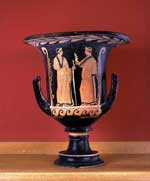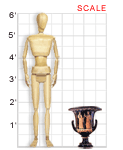VAM galleries including this work:
The Speed Art Museum | Art Through Time || VAM Home
Python (Greece)
CALYX KRATER, about 350-340 BCE
Earthenware with slip decoration; 18" X 15"
Gift of the Charter Collectors, 90.7
The Speed Art Museum
The ancient era when the Greek city of Athens was at its most influential is considered to be the classical period in Greece. After a series of military conflicts with the Persians that began in 499 BCE, the Greeks’ ultimate victory over the Persians in 479 BCE ushered in a golden age of art and culture. Over the next 100 years, many of the finest examples of Greek architecture, sculpture, and pottery were created. The end of the classical period in Greece was signaled by a number of military conflicts and the growing power of King Phillip of Macedon.
A powerful belief in the inherent good and the creative possibilities of man—the philosophy that we know today as humanism—was born during this cultural period. From this humanist philosophy proceeded a universal ideal of beauty that could be achieved through logic, order, reason, and moderation. As the classical Greek philosopher Plato stated, “[B]eauty of style and harmony and grace and good rhythm depend on simplicity—I mean the true simplicity of a rightly and nobly ordered mind and character.”
During the classical period in Greece, many objects used in daily life reflected the Greeks’ understanding of ideal beauty. In the design of this krater, a vessel used for mixing wine with water, the artist has integrated classical ideals of harmony and balance into the overall shape and decorative details. This example is called a calyx krater because it is shaped like a calyx—the cup-like outer leaves of a flower bud. In the design of the krater, symmetry serves both a practical function—the handle on each side of the krater makes it easier to lift or move—and as a graceful way to balance the design on the back of the krater. The design of two male figures facing each other, shown on the back, is an elegant decorative example of symmetry. The wreaths they wear on their heads may indicate that they are victorious athletes. This vessel is from Paestum, a Greek colony in southern Italy in ancient times.
About the Artist
This vessel is thought to have been created by Python. While it is fairly uncommon to know the identity of an ancient potter, Python was prolific, producing a large number of works. The detailed painting on the vessel reflects his distinctive hand, and his love of ornament and texture appears in the rich patterns on the figures’ garments. The pattern of dots and stripes that borders the costumes is another characteristic of Python’s work.
Classroom Ideas
Discussion: This krater is an example of functional art. What types of functional art do we use today? Are designer goods and fashions in today’s world examples of functional art? This Greek krater may show victorious athletes. Where and how are images of victorious athletes shown in contemporary American society? (On the front of Wheaties cereal boxes, on commemorative cups from fast-food restaurants, printed on T-shirts, etc.) Discuss how this krater reflects ancient Greek ideals of beauty. What are the ideals of beauty in our society, and how do they differ from those of the Greeks? What do the ideals of beauty in both cultures tell us abut what is most valued within the respective cultures?
Activities:
Design your own krater in the Greek style or paint terracotta flower pots in Greek style.
Discuss symmetry and balance. Then create a symmetrical design using paints/watercolors.
An easy way to do this is to fold a piece of paper in half, paint on the outside
half, and then fold the sheet back together while pressing down on top of the
painting. When you open the sheet back up, you should have a perfectly symmetrical
painting!
Create a collage of what you think might be considered beautiful in our
society by cutting out pictures from a magazine. Discuss identity and aesthetic
values in contemporary culture.
Create a 2-D commemorative vessel by drawing the shape of the vessel and
cutting it out of thin cardboard. Decorate it with collaged images of contemporary
athletes or cultural figures.
Links
Other examples of Greek kraters can be found at the ArtLex web site.
[www.artlex.com/ArtLex/kl/krater.html]
Explore the world of the ancients at AncientGreece.com.
[www.ancientgreece.com]
The BBC web site has a kids’ look at ancient Greece.
[www.bbc.co.uk/schools/ancientgreece/main_menu.shtml]

